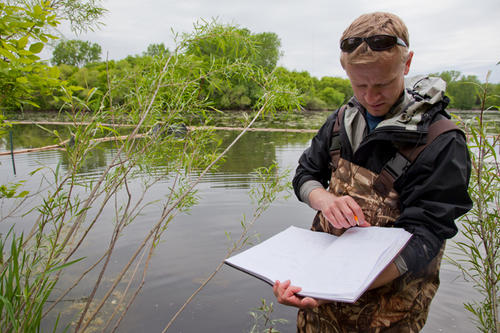
The Minnesota Aquatic Invasive Species Research Center (MAISRC) announced the launch of six new research projects, on topics ranging from assessing the impacts of aquatic invasive species (AIS) on walleye populations, prioritizing cleaning efforts for reducing the spread of spiny waterflea, and creating a decision-making tool to help counties better allocate AIS funds. These projects were selected as part of a competitive proposal process following a comprehensive needs assessment conducted by MAISRC. The results of these projects will lead to better prevention of aquatic invasive species and improved management of Minnesota’s resources, including the species impacted by AIS. The projects include:
- Determining highest-risk vectors of spiny waterflea spread, led by Dr. Valerie Brady. This study will quantify the relative risk of spread posed by spiny waterflea attaching on commonly used recreational equipment. Results will be disseminated to anglers, the tourism industry, and lake associations and will help recreationalists prioritize their cleaning efforts in order to prevent further spread of spiny waterfleas.
- Cost-effective monitoring of lakes newly infested with zebra mussels, led by Dr. John Fieberg. This study will develop recommendations for underwater survey methods to estimate zebra mussel population abundance and distribution in newly infested lakes. This will guide treatment options and post-treatment monitoring.
- Sustaining walleye populations: assessing impacts of AIS, led by Dr. Gretchen Hansen. This study will quantify the impacts of zebra mussels and spiny waterfleas on walleye and their food webs in large lakes in order to identify management strategies.
- Building scientific and management capacity to respond to invasive Phragmites in Minnesota, led by Dr. Daniel Larkin. This project will map invasive Phragmites statewide, assess its reproductive potential, and develop management protocols for responding to different invasion scenarios.
- Eurasian and hybrid watermilfoil genotype distribution in Minnesota, led by Dr. Ray Newman.
This project will quantify the genetic diversity of Eurasian, hybrid, and northern watermilfoil in Minnesota lakes in order to identify relationships among genetic composition and environmental conditions, native plant communities, and herbicidal management history. - Decision-making tool for optimal management of AIS, led by Dr. Nicholas Phelps. This project will develop a decision-making tool to help AIS managers, counties, and other agencies prioritize their resources for optimal prevention and intervention of AIS, specifically zebra mussels and starry stonewort. It will take into account water connectivity, boater movement, species-specific ecological niche models, and more.
MAISRC is proud that these projects bring in experts from numerous fields to build capacity and help solve AIS problems for Minnesota, including scientists from the University of Minnesota Duluth, University of Minnesota Twin Cities, the Minnesota DNR, the Chicago Botanic Garden, Montana State University, the U.S. Forest Service, the Natural Resources Research Institute, and the University of Minnesota School of Public Health.
Interested members of the public are invited to learn more about these projects and all MAISRC research at the 2017 Aquatic Invasive Species Research and Management Showcase on Sept. 13. Space is limited and pre-registration is required.
The Minnesota Aquatic Invasive Species Research Center was founded in 2012 with funding from the Clean Water Fund and the Environment and Natural Resources Trust Fund and with the support of the Minnesota Legislature. Its mission is to develop research-based solutions that can reduce the impacts of aquatic invasive species in Minnesota by preventing spread, controlling populations, and managing ecosystems; and to advance knowledge to inspire action by others. Learn more about findings and current research at www.maisrc.umn.edu.
- Categories:
- Agriculture and Environment





